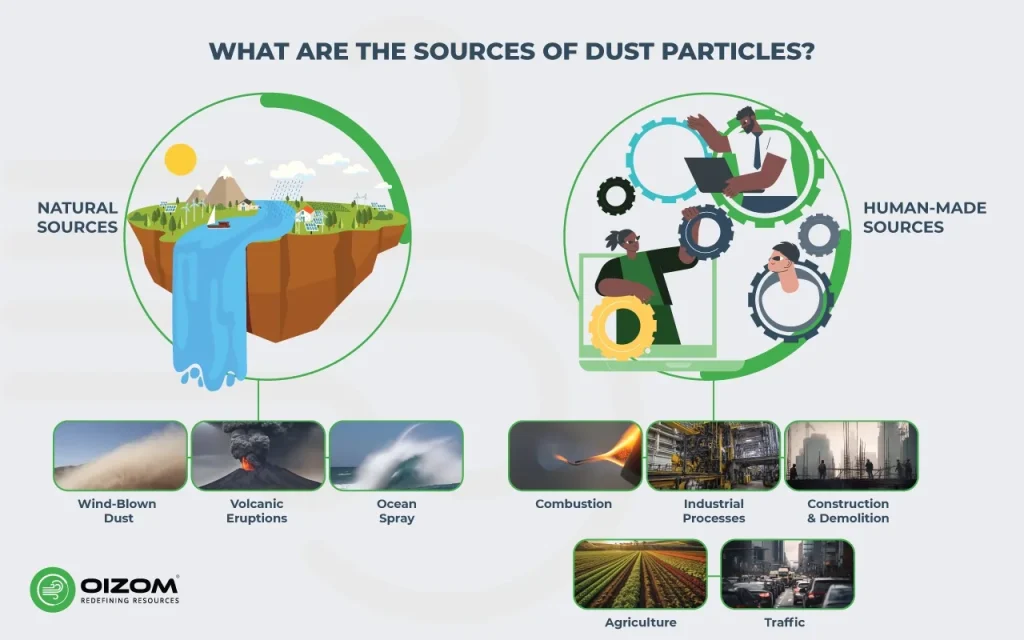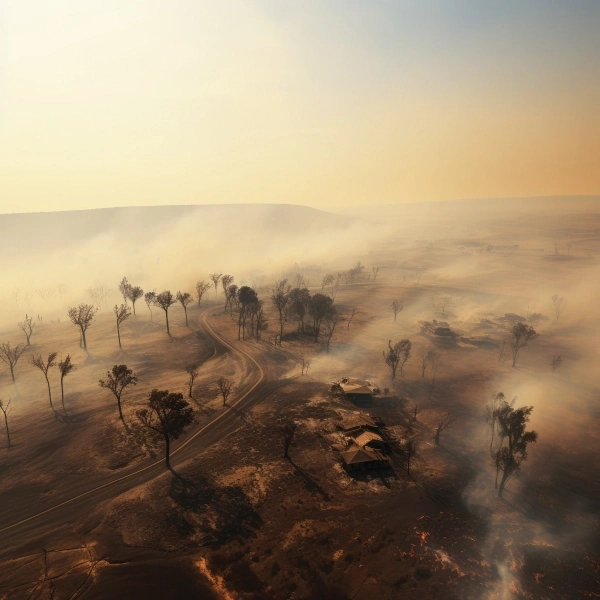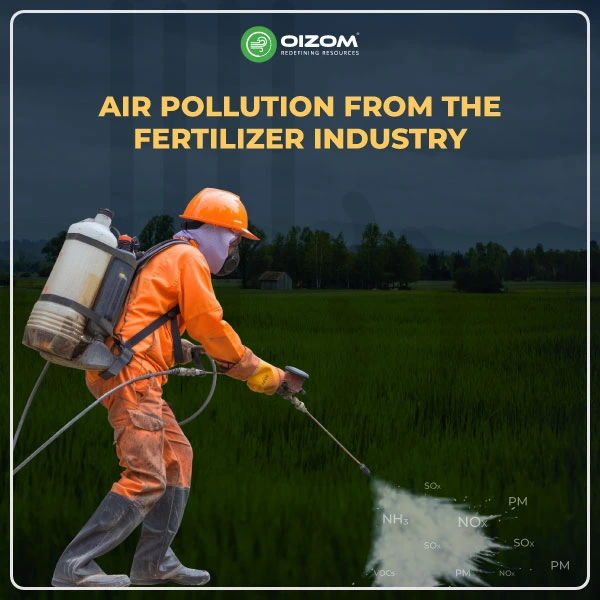In the broader climate change narrative, which is often dominated by concerns about greenhouse gases such as carbon dioxide and methane, a less visible but equally important plays a critical role: dust particles. These particles, commonly called particulate matter (PM), are more than just components of the air we breathe; they play essential roles in the complexity of the Earth’s climate system.
When we often think of dust particles, images of a dusty bookshelf or a hazy city skyline might come to mind, underscoring their presence as a problem or a pollution marker. Yet, beyond these everyday encounters lies a profound impact on the climate. These minuscule particles, varying in size from a few to tens of micrometres, interact with the fundamental elements of our climate system, sunlight, clouds, and precipitation in ways that significantly alter the Earth’s energy balance and, consequently, its climate patterns.
This blog post invites you on an exploratory journey into the intricate world of dust particles and their connections to climate change. As we navigate this narrative, we’ll unravel how dust particles influence the Earth’s radiative balance, a delicate equilibrium critical to our planet’s climate. We’ll probe into their impact on cloud formation and properties, examining how these tiny particles can shape the very clouds that play a pivotal role in regulating our climate.
What are dust particles?
Dust particles, also known as particulate matter (PM), are minuscule fragments suspended in the air, invisible to the naked eye but omnipresent in our environment. These particles, ranging in size from a few to tens of micrometres, are about 1/25th the width of a human hair, highlighting their tiny scale. Their presence and impact on human health and the environment are profound, necessitating a deeper understanding of their nature and origin.
Types and Impact of Dust Particles
Dust particles vary in size and composition, influencing their potential health effects. PM10 particles, with diameters less than 10 micrometres, can penetrate the lungs and cause respiratory issues. More concerning are PM2.5 particles, which are less than 2.5 micrometres in diameter and can penetrate deep into the lungs and bloodstream, posing significant health risks.
Inhalable dust, more significant than 10 micrometres, is primarily trapped in the upper airways but can cause irritation and coughing. Respirable dust, smaller than 10 micrometres, can reach the lower airways and lungs, potentially leading to respiratory illnesses.
| Name | Size (μm) | Sources | Health Effects |
|---|---|---|---|
| PM10 | < 10 | Soil, construction, transportation emissions | Respiratory irritation, coughing |
| PM2.5 | < 2.5 | Fossil fuel combustion, secondary aerosols | Respiratory illnesses, cardiovascular issues |
| Inhalable dust | > 10 | Agriculture, windblown dust | Upper airway irritation |
| Respirable dust | < 10 | Industrial emissions, traffic fumes | Lung damage, heart problems |
Mitigation Strategies
Mitigating dust pollution requires addressing both natural and human-made sources. Controlling industrial emissions through stricter standards and cleaner technologies can reduce PM emissions. Promoting cleaner transportation, like public transport, electric vehicles, and cleaner fuels, can help reduce car emissions.
Dust control measures like minimal tillage and mulching in agriculture can mitigate dust emissions. Forest protection is also vital in preventing soil erosion, a primary dust source. Lastly, raising public awareness about the origins and health effects of dust pollution can foster behavioural changes, contributing to reduced dust levels.
How are dust particles formed?
Understanding the formation of dust particles, which occur through natural and man-made processes, is crucial for developing strategies to mitigate their impact.
Composition and Size of Dust Particles
The composition of dust particles varies, including soil and mineral particles from natural sources like deserts and construction sites, combustion byproducts from burning fossil fuels, and secondary aerosols formed from atmospheric gas reactions. These particles range in size, with PM10 particles being less than 10 micrometres in diameter and capable of causing respiratory irritation. In contrast, PM2.5 particles, smaller than 2.5 micrometres, can penetrate the lungs and bloodstream, posing significant health risks. Inhalable dust, more prominent than 10 micrometres, generally gets trapped in the upper airways, while respirable dust, smaller than 10 micrometres, can reach the lower respiratory tract.
What are the sources of dust particles?

Dust particles, called particulate matter (PM), are microscopic solids or liquids suspended in the air. While invisible to the naked eye, they are a significant component of the atmosphere and arise from various natural and human-made sources. Their presence and effects are far-reaching, impacting everything from air quality to human health and environmental integrity.
Natural sources
Wind-Blown Dust: One of the most prominent natural dust sources is wind-blown dust from deserts, drylands, and agricultural fields. Strong winds lift and transport these particles across vast distances in arid regions, contributing significantly to the regional and even global dust load.
Volcanic Eruptions: Volcanoes are another natural source of dust particles. During eruptions, they emit large quantities of ash and other particulate matter into the atmosphere. This material can form dust storms capable of travelling long distances, affecting areas far from the eruption site.
Ocean Spray: The interaction of ocean waves with the shoreline generates sea salt aerosols, a key component of coastal atmospheric dust. These aerosols contribute to the overall atmospheric dust burden and are especially relevant in coastal regions.
Human-made sources
Combustion: The burning of fossil fuels, such as coal, oil, and natural gas, is a significant anthropogenic source of dust particles. This process releases pollutants, including delicate particulate matter, into the atmosphere, exacerbating air pollution.
Industrial Processes: Various industrial activities, including mining, smelting, and power generation, contribute to dust pollution by releasing large amounts of particulates into the air. These processes are particularly relevant in industrialised areas.
Construction and Demolition: The structure and demolition of buildings and infrastructure are significant dust sources. Road construction and building demolition can generate substantial dust, impacting air quality in surrounding areas.
Agriculture: Agricultural practices, including tilling, harvesting, and livestock management, release dust particles into the air. These activities, especially in large-scale farming, can significantly contribute to atmospheric dust levels.
Traffic: Vehicle emissions, mainly from diesel engines, are a significant source of fine dust particles in urban areas. Traffic-related dust pollution is growing in densely populated and heavily trafficked cities.
What are the different types of dust particles?
Dust particles, often dismissed as mere irritants, are a complex and significant aspect of our environment, impacting everything from air quality to human health. These tiny airborne particles, which vary in size from a few micrometres to tens of micrometres, have diverse origins and effects. A deeper understanding of the different types of dust particles is essential for evaluating their impact and devising strategies to mitigate their effects.
Categorising Dust Particles by Size
Classifying dust particles by size is crucial, as size largely determines their impact on human health and the environment.
- PM10 Particles: These particles have a diameter of less than 10 micrometers. Small enough to penetrate the upper respiratory tract, PM10 particles can cause respiratory irritation and coughing.
- PM2.5 Particles: Also known as fine particles, they are less than 2.5 micrometres in diameter. Their diminutive size allows them to deeply infiltrate the lungs and even enter the bloodstream, presenting significant health risks.
- Inhalable Dust: These larger particles, exceeding 10 micrometres, are generally trapped in the upper airways. They are less likely to cause severe health issues compared to finer particles.
- Respirable Dust: Particles smaller than 10 micrometres can reach the lower airways and lungs, posing a risk of respiratory illnesses.
Categorizing Dust Particles by Composition
Dust particles can also be categorized based on their composition, each type having unique sources and effects:
- Soil and Mineral Dust: Originating from natural processes like soil erosion and volcanic eruptions, these particles are a common component of outdoor dust.
- Organic Matter: This category includes particles like dead skin cells, pollen, plant fibres, and animal dander, which are predominantly found in indoor environments.
- Combustion Byproducts: Resulting from the burning of fossil fuels, wildfires, and industrial activities, these particles include soot and ash.
- Secondary Aerosols: Formed through chemical reactions between atmospheric gases, these particles often originate from industrial and vehicular emissions.
How many dust particles are in the air
The quantification of dust particles in the air is a subject of continuous scientific inquiry, offering insights into environmental health and guiding public health strategies.
Measuring Dust Particle Concentration
The density of dust particles in the air is typically quantified in micrograms per cubic meter (µg/m³). This measurement reflects the weight of these particles within a specified air volume, providing a standardised metric for assessing air quality.
Factors Influencing Dust Particle Concentration
The concentration of dust particles in the air is not static; it fluctuates based on various factors:
- Location: Urban and industrial areas usually exhibit higher dust particles due to increased human activities releasing particulates.
- Meteorological Conditions: Weather patterns, including wind, rain, and atmospheric pressure, influence the movement, spread, and deposition of dust particles.
- Natural Sources: Phenomena like dust storms, volcanic eruptions, and sea spray significantly contribute to the atmospheric dust particle load.
- Human-made Sources: Activities such as combustion (especially of fossil fuels), industrial operations, construction work, and agricultural practices are critical contributors to dust particle emissions.
Average Dust Particle Concentrations
Globally, the average concentrations of PM10 (particles with a diameter of 10 micrometres or less) generally hover between 20 to 30 µg/m³. However, this average can vary markedly depending on geographical location, industrial activity, and environmental policies.
Monitoring Dust Particle Levels
Monitoring stations strategically placed worldwide are pivotal in measuring dust particle concentrations. These stations provide crucial data that helps assess air quality, formulate public health advisories, and devise pollution control measures.
Oizom’s dust monitoring system employs advanced sensors for accuratereal-time tracking of airborne particulates, crucial for ensuring environmental and health safety standards. Its data, accessible via cloud-based platforms, aids in immediate response and long-term air quality management. This system is essential in industrial and urban settings for maintaining compliance and mitigating health risks.
What are some of the benefits of dust?
Dust, often considered an insignificant or bothersome element in our daily lives, plays a surprisingly significant role in numerous environmental processes. These tiny particles, floating ubiquitously in the air, contribute to everything from cloud formation to the fertilisation of remote ecosystems. Exploring the hidden benefits of dust particles reveals their crucial contribution to the delicate balance of our planet’s ecological and climatic systems.
- Cloud Condensation Nuclei
One of the critical roles of dust particles is in forming clouds. They serve as cloud condensation nuclei, providing a surface for water vapour to unite into droplets. This process is vital for cloud formation, impacting the Earth’s water cycle and influencing precipitation patterns. Without these particles, the construction of clouds would be significantly hindered, disrupting weather systems and global water distribution.
- Nutrient Transport
Dust particles, especially those originating from deserts and volcanic eruptions, carry vital nutrients. They transport elements like iron over vast distances, which is critical in nourishing marine ecosystems. This nutrient deposition is crucial in nutrient-poor regions of the world’s oceans, supporting plankton growth and sustaining aquatic food chains.
- Radiative Effects
Dust particles interact with sunlight in complex ways, scattering and absorbing solar radiation. This interaction directly impacts the Earth’s radiative budget, influencing climate patterns. In some cases, dust can contribute to cooling by reflecting sunlight away from the Earth’s surface or warming by absorbing heat, depending on their composition and the environmental context.
- Soil Formation
Contributing to soil formation is another lesser-known benefit of dust particles. In regions where soil erosion is prevalent, the deposition of dust particles adds to the development of new soil layers. These particles, organic matter, and other soil components create fertile land essential for vegetation growth and agricultural productivity.
- Seed Dispersal
In the realm of plant biology, dust particles assist in seed dispersal. They can attach to seeds, facilitating their transport over long distances, thus aiding plant species’ colonisation of new areas and maintaining biodiversity. This natural dispersal mechanism is crucial for the spread of various plant species, enhancing ecological diversity.
- Historical Records
Dust particles serve as a historical archive, offering insights into past environmental conditions. Trapped in ice cores and sediment layers, they provide clues to historical climate patterns, volcanic activities, and changes in vegetation. Scientists can reconstruct ancient environmental scenarios by analysing these particles, contributing to our understanding of Earth’s climatic history.
- Atmospheric Chemistry
Dust particles play a role in atmospheric chemistry by providing surfaces for chemical reactions. These reactions can lead to the formation of secondary aerosols and the removal of pollutants from the atmosphere. This process is crucial in understanding and managing atmospheric composition and pollution levels.
How dust particles can transport harmful pollutants
Understanding the mechanisms through which dust particles carry pollutants is critical for addressing air quality and public health issues.
Mechanisms of Pollutant Transport
- Adsorption: Pollutants can attach to the surface of dust particles through adsorption. This process involves the attraction between the molecules of the pollutant and those of the dust particle, creating a bond that allows for transporting these harmful substances.
- Absorption: Pollutants can also be integrated into the interior of dust particles through absorption. In this process, pollutant molecules diffuse into the particles’ pores or cracks, becoming a part of the particle.
- Entrapment: In some cases, pollutants are trapped within the matrix of dust particles. This can happen during the formation of the particles around pollutant molecules or when pollutants become entangled in the fibres or structures of the particles.
Transportation and Impact
Once pollutants are attached to or encapsulated within dust particles, wind currents can carry them long distances. This transportation means that pollutants can reach areas far removed from their original emission sources. The smaller the dust particles, the greater their capacity for pollutant transport due to a larger surface area relative to volume and an increased likelihood of remaining airborne for extended periods.
Examples of Pollutant Transportation
- Industrial Dust: Dust particles from industrial facilities may contain heavy metals like lead and mercury, posing significant health risks upon inhalation or ingestion.
- Agricultural Dust: Dust from farm activities can carry pesticides and herbicides, harming human health and ecosystems.
- Construction Dust: Dust generated at construction sites can contain asbestos, a known carcinogen, posing severe health risks.
- Traffic-Related Dust: Dust from road traffic can include pollutants like soot, nitrogen oxides, and sulfur dioxide, contributing to respiratory ailments and heart disease.
Mitigation Strategies
Controlling emissions from natural and human-made sources is crucial to curb the transport of harmful pollutants by dust particles. This can be achieved through:
- Implementing stringent emission standards for industries.
- Minimising the use of harmful chemicals in agriculture.
- Utilising safer materials and practices in construction.
- Encouraging public transport, electric vehicles, and cleaner fuel options.
The role of dust particles in climate change
Dust particles, often perceived as a trivial atmosphere component, play a surprisingly intricate role in climate change. These tiny airborne particles, known as particulate matter (PM), directly and indirectly influence the Earth’s climate system, contributing to the complexity of climate dynamics.
Direct Radiative Effects
Dust particles interact with solar radiation in two primary ways:
- Scattering Effect: Dust particles can scatter incoming solar radiation back into space. This process reduces the amount of solar energy reaching the Earth’s surface, thereby cooling the planet. The extent of this effect depends on the size and colour of the particles; generally, larger and lighter-coloured particles are more effective scatterers.
- Absorption Effect: Conversely, dust particles can absorb solar radiation and convert it into heat. This absorption can lead to a warming effect, particularly in areas with high concentrations of dark-coloured dust particles. The warming impact is significant in regions with large amounts of such particles suspended in the atmosphere.
The balance between these scattering and absorption effects hinges on factors like the particles’ size, composition, and concentration, making their impact on climate complex and variable.
Indirect Radiative Effects
Dust particles also indirectly influence climate through their interaction with cloud formation:
- Cloud Condensation Nuclei: Dust serves as nuclei around which water vapour can condense to form cloud droplets. This role in cloud formation can change cloud cover and properties, potentially altering the Earth’s energy balance.
- Cloud Albedo: Clouds have a high albedo, which effectively reflects sunlight. Dust particles within clouds can affect this reflective capacity, altering the amount of solar energy reflected in space. Changes in cloud albedo can have significant implications for regional and global climates.
Impact on Precipitation Patterns
Dust particles can also influence global and regional precipitation patterns. These particles can modify rainfall’s distribution, frequency, and intensity by affecting cloud formation and atmospheric dynamics, impacting water resources and ecosystems.
Long-term Climate Change
The long-term effects of dust particles on climate change are a subject of ongoing research. Their interactions with various climate system components, such as greenhouse gases, atmospheric circulation, and solar radiation, make their impact complex and multifaceted.
Conclusion
As an environmental expert, our analysis yields a conclusive understanding of these particles’ multifaceted influence on the planet’s climate dynamics. Dust particles, often undervalued in climate conversations, are pivotal in shaping atmospheric conditions.
Ongoing Research and Future Implications
The full extent of the impact of dust particles on long-term climate trends remains a subject of active research. As we uncover more about these particles’ interactions with other climate components and processes, our understanding of climate change deepens, revealing a more detailed and exact picture. This ongoing research is critical in shaping effective climate change mitigation and adaptation strategies.
In conclusion, dust particles, though small, have a profound impact on Earth’s climate. Their diverse interactions within the climate system underline the complexity of our challenges in addressing climate change.
Beyond environmental concerns, it’s also crucial to consider the Economic Impacts of dust contamination, as these fine particles contribute to rising public health costs, agricultural losses, and infrastructure degradation. By acknowledging and integrating the role of dust particles into our strategies, we can develop more holistic and practical approaches to safeguarding our planet’s climate, ensuring a more sustainable and resilient future for all.
FAQS
Reducing exposure to dust particles involves a combination of personal and household measures:
- Clean and vacuum regularly, using HEPA filters.
- Keep indoor humidity at 30-50%.
- Ensure good ventilation in your home.
- Use air purifiers with HEPA filters.
- Wear masks in high-dust areas.
- Grow indoor plants like Snake plants and English ivy.
- Monitor local air quality and limit outdoor activities when dust levels are high
Governments worldwide take various steps to regulate and control dust particles, primarily focusing on reducing emissions from industrial, agricultural, and vehicular sources:
- Implementing emission standards for industries and vehicles.
- Monitoring air quality and issuing advisories.
- approve policies to control dust-emitting activities.
- Investing in research on dust particles.
- Running public awareness campaigns.
- Engaging in international cooperation to manage air pollution.
For those interested in learning more about dust particles, several resources are available:
- Environmental Protection Agency (EPA) for information on particulate matter.
- World Health Organization (WHO) for global air quality guidelines.
- National Institute for Occupational Safety and Health (NIOSH) for workplace dust safety.
- Scientific journals like Atmospheric Environment and Journal of Aerosol Science.
- Local environmental and public health departments.






